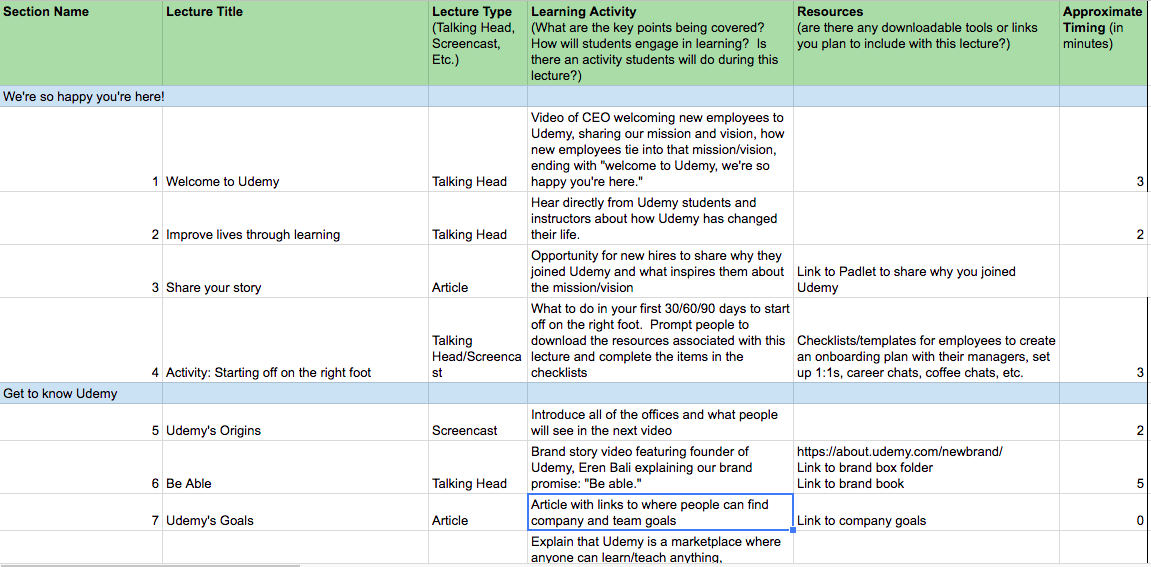One of the challenges a newbie online course creator might encounter is writing a lesson plan.
Lesson plans are written differently depending on what course is to be taught and to whom it is to be taught. For instance, on a particular course, you could provide three lesson plans when you are creating a course that features a beginner, intermediate and expert. So, a course’s “what” and “to whom” are important. Writing a lesson plan is as important as delivering that lesson plan.
To conquer the challenge of writing a lesson plan, I will share the format of writing a lesson plan in this article.
Table of Contents
What is a Lesson Plan?
Lesson plan is a detailed outline or guide that help course creators plan and organize their course. They are designed to help course creators focus on a lesson’s learning objectives and goals and ensure that the lesson is well-organized and structured. A lesson plan typically includes learning objectives, materials and resources, an introduction, a body, a conclusion, and assessments.
A lesson plan should contain the what learners expect and will need for their learning and effectively communicates the intentions of the person presenting that lesson. For a lesson plan to effectively fulfil its purpose, it should contain all the components required to deliver the lesson’s objectives effectively.
There are many different ways to write a lesson plan, and the specific format and content of a lesson plan will depend on the creator’s teaching style, the subject matter, and the needs and abilities of learners. Some course creators prefer structured and detailed lesson plans, while others prefer more flexible and open-ended plans.
Importance of Writing a Lesson Plan
There are several important reasons why writing lesson plans is important for course creators:
- They help course creators be better prepared for creating a outline. By outlining the key points and activities in advance, course creators can focus on delivering the lesson rather than going off track.
- They can help course creators anticipate and address potential challenges or difficulties during the lesson. By thinking through the lesson in advance, course creators can identify potential problem areas and plan ways to manage them.
- They help ensure that the lesson is aligned with what people need and meets the learning objectives. By following a lesson plan, course creators can be confident that they are covering the expected material and helping their learners’ progress towards the learning goals.
- They provide a structure for the lesson, which helps keep the class on track and moving forward. Without this lesson plan, there would be no framework within which the lesson would be delivered. They allow course creators to tailor their studies to the needs and abilities of their students. By creating a lesson plan in advance, course creators can consider the individual needs of their students and plan activities and assessments that are appropriate and challenging for each student.
- They help course creators be more efficient and effective in their teaching. By having a clear plan in place, course creators can make the most of their time and resources and more easily adapt their lessons to meet the needs of their students.
- They can be a reference or resource for course creators, allowing them to reflect on past lessons and use them as a starting point for future lessons.
Component of A Lesson Plan
What are the key components of a lesson plan?
There are several key components that are typically included in a lesson plan:
-
Learning objective
The learning objective is a key component of how to write a lesson plan because it helps to focus the lesson and ensure that the material being presented is aligned with specific learning goals. The objective should be specific and measurable and state what the students will be able to do or know by the end of the lesson. For example, an objective might be “By the end of the lesson, learners will be able to understand the importance of marketing for businesses.”
Having a clear objective helps the creator plan the content and activities for the lesson, and it also helps the students understand the purpose of the lesson and the skills or knowledge they will be expected to learn.
In addition, the objective can serve as a guide for assessment. It will provide a clear and measurable way to determine whether the students have achieved the lesson’s learning goals.
-
Materials
Materials are an important component of writing a lesson plan because they can help support and enrich the learning experience for the students. The materials listed in the lesson plan should be relevant to the objective of the lesson and should be used to facilitate the learning process.
For example, the lesson’s objective is to teach the rules of colours in designing. In that case, the materials might include e-textbooks, diagrams, models, or videos that provide visual aids to help the learners understand the presented concepts.
Including a list of materials in the lesson plan can help the course creator ensure they have everything they need to deliver the lesson effectively. It can also help the students know what to expect and come prepared to engage with the material.
-
Introduction
An introduction is a crucial component of how to write a lesson plan because it helps set the stage for the rest of the lesson. It is an opportunity to engage the students, grab their attention, and provide some context for their learning material. A good introduction should be interactive, relevant, and interesting, and it should communicate the learning objectives for the lesson.
The introduction should also establish a positive learning environment and create a sense of excitement and curiosity about the topic. In short, the introduction is an essential part of a lesson plan because it helps set the stage for a successful and engaging learning experience.
-
Direct instruction
Direct instruction is a key component to be considered when determining how to write a lesson plan because it is a teaching method that involves the creator actively presenting information to the students in a structured and systematic way. This is the main body of the lesson, where the teacher introduces new information or skills to the students. This can include lectures, demonstrations, or explanations of concepts or skills.
The goal of direct instruction is to provide the students with the knowledge and skills they need to be successful in the lesson and to help them understand the material being taught. One advantage of using direct instruction is that it allows the teacher to present information in a clear and organized way, which can be especially helpful for struggling students to understand the material.
Are you interested in content like this? Follow us on instagram and enjoy posts on writing, freelancing, and online business success.
-
Guided practice
Guided practice is a key component to consider when determining how to write a lesson plan because it helps students apply what they have learned during the direct instruction portion of the lesson, which can help build their confidence and understanding of the material.
This can include completing tasks, quiz, etc., that allow students to practice the skills or concepts taught. It also allows the teacher to observe the students as they work and provide feedback and support as needed.
-
Independent practice
This is also a crucial component of how to write a lesson plan, mainly because it creates an opportunity for the students to apply the new skills or knowledge they have learned from their course creators on their own.
-
Review and Assessment
As a component of how to write a lesson plan, this is a time for the teacher to review the material covered in the lesson and assess the students’ understanding. This might include a test or other form of assessment.
-
Conclusion
This is a key component of how to write a lesson plan because it indicates the end of the lesson and is used to summarize the main points and review the objectives. It might also include an activity to help the students reflect on their learning.
Read Also: Differences between Free and Paid Courses in Freelancing
Format for Writing A Lesson Plan
There are several steps involved in writing a lesson plan:
-
Determine the objectives of the lesson
This is the foremost step that must be considered when you want to write a lesson plan. The first question that comes to mind is, “What do I want the learners to understand?” If you can determine the objectives of the lesson, then you have answered the question.
-
Choose a suitable topic for the course
This is the next step that is taken in how to write a lesson plan. This is usually related to the objectives of the lesson. A suitable topic can convey the set objectives.
-
Determine the level of your students
This step in writing a lesson plan is also crucial. Having a thorough knowledge of your students will help you choose appropriate materials and activities for the lesson.
-
Plan the structure of the lesson

Example of Course Outline – Udemy
Planning out the lesson structure is one of the steps in writing a lesson plan. This might include an introduction, the main activities, and a conclusion.
-
Choose appropriate materials and resources
Preparing suitable materials and resources for the topic you intend to teach is one step in writing a lesson plan. These materials are important for the visual learning of the students. This might include texts, videos, images, or other materials.
-
Plan the activities and exercises
The activities your students must carry out should be designed to help them achieve the lesson’s objectives.
-
Choose a viable assessment
Assessment is a key component of learning. Having a strategy for assessing your students’ learning is a step in figuring out how to write a lesson plan. This might include quizzes, tests, or other types of assessments.
-
Write the lesson plan
When you have done all the above steps, the next thing to do is to write the lesson plan. Your lesson plan should include a clear outline of the lesson’s objectives, materials, activities, and assessments and a suitable conclusion to the lesson, knowing that the objectives have been fulfilled.
-
Review and revise
When you have successfully written a lesson plan, you should do a review of the plan. This might involve seeking feedback from colleagues or testing the lesson plan in a trial run.
Read Also: The Pros and Cons of Mixing Online Courses with School Works
Benefits of Writing a Lesson Plan in Advance
There are several benefits to writing a lesson plan in advance. These benefits include:
-
A well-organized lesson
Planning helps to ensure that the lesson is well organized and that all necessary materials are prepared in advance.
-
A focused lesson
A lesson plan can help course creators stay on track and avoid going off tangents or covering material irrelevant to the lesson. By considering the lesson’s learning objectives, course creators can tailor their instruction to meet the needs of their students.
-
Anticipate problems
A lesson plan can help course creators anticipate potential problems or challenges during the lesson and plan for ways to address them.
-
Source of reference
A lesson plan can be a useful reference for course creators, helping them remember key points before publishing the course.
-
Improvement
A lesson plan can help course creators reflect on their teaching and make improvements for future lessons.
-
Aid learners’ preparation
A lesson plan helps the learner know what to anticipate in the course. It gives them an overview of what will be covered in the lesson and what they can expect to learn.
Online Learning Platforms for Course Creation
Knowing how to write a lesson plan is not enough, you should the platforms where you can upload your courses. You can also get paid for the course if you want.
-
Udemy
The platform has over 50 million students enrolled in different courses and a rising number of 75,000 tutors. You can create a paid course on Udemy. To create a paid course on Udemy, you must first submit a premium instructor application. Once approved, you will be presented with simple steps to help create your first course.
Keep in mind that all courses require at least 30 minutes of video and five lectures as you plan course content. You may add quizzes, assignments, coding exercises, and discussion questions.
Why should you create your course on Udemy? Because the platform provides abundant assistance for developing and promoting a course. For instance, if you need clarification on the quality of your video lessons, you can submit a sample for review and receive feedback on video, audio, and equipment recommendations. And Udemy’s Teaching Center provides tutorials on planning a course, filming your first video, and other related topics.
-
Teachable
Teachable is another fantastic platform or website that allows you to create and sell online courses.
When it comes to course delivery, Teachable enables you to add multiple content types, such as videos and quizzes, to your course, drip your course content, create course completion certification, and ensure course compliance. And it also has a very well-designed course player, resulting in a great learning experience for the students.
-
Skillshare
Skillshare is an excellent platform for teaching creative skills. There are courses on various popular and niche subjects, including marketing, photography, cooking, hand painting, doodling, and even wall hanging.
Skillshare classes, free or premium, consist of three major components: video lessons, a project, and community discussion. Each class consists of 20 to 60 minutes of video divided into 2 to 5-minute lessons. The practical project guarantees practical experience.
For example, a social media class project may require students to promote their Instagram accounts, while a writing class may require students to compose a pitch. The final component of a course allows students to post their work.
-
Thinkific
Thinkific is simply remarkable in terms of course delivery and student participation. It permits the addition of multiple content types, such as videos, quizzes, text, PDFs, surveys, etc.
You can also provide course completion certificates, and it’s currently the greatest selling point for online courses because they enable students to showcase their skills on LinkedIn and resumes. In addition, they enable the creation of learning paths with prerequisites and locked lessons, which is ideal for skill-based instruction.
Read Also: Online Learning Platforms for Career Development – Free Resources
Conclusion
In conclusion, writing a lesson plan as a course creator is important in creating an effective and engaging course. It involves determining the lesson’s objectives, choosing a suitable topic, selecting appropriate materials and resources, and planning activities and assessments.
By following these steps and being mindful of the needs and levels of your students, you can create a lesson plan that helps them achieve their learning goals.
It is also important to regularly review and revise your lesson plan to remain relevant and effective. With careful planning and attention to detail, you can create a lesson plan that is engaging and effective for your students.
Are you interested in online content writing but not sure how to proceed? Send us a message on Whatsapp now!
About Author
- I am an enthusiastic content and creative writer. I harness opportunities to make fact-based, fictional and SEO-enhanced creative content that are captivating, interesting and worthwhile.
Latest entries
 CampusDecember 11, 2023Who is a Notary Public, and Why Might You Need One as a Student
CampusDecember 11, 2023Who is a Notary Public, and Why Might You Need One as a Student EntrepreneurNovember 30, 2023All You Need to Know About Venture Capital As a Nigerian Entrepreneur
EntrepreneurNovember 30, 2023All You Need to Know About Venture Capital As a Nigerian Entrepreneur CareerJuly 26, 2023How to Become a Business Intelligence Analyst in Nigeria
CareerJuly 26, 2023How to Become a Business Intelligence Analyst in Nigeria Business InsightsMay 17, 2023Top 8 Direct Marketing Strategies for Nigerian Business Owners
Business InsightsMay 17, 2023Top 8 Direct Marketing Strategies for Nigerian Business Owners

